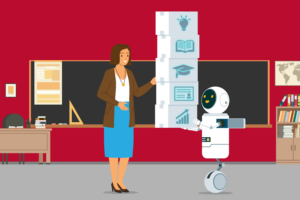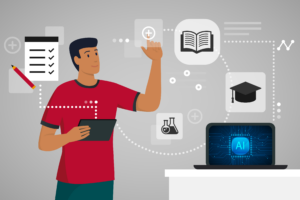What was the first thing you typed into ChatGPT?
Did you ask it to make travel plans to Costa Rica or create code for your new website? Maybe, like hundreds of thousands of college students across the globe, you saw an opportunity, a chance to support your education with one of the most powerful artificial intelligence tools ever created.
ChatGPT, along with many other types of machine learning, is changing how we translate knowledge in higher education. Though there is a fear that AI tools can inhibit learning and encourage shortcuts, research has shown that AI can be as much a tool as a laptop or a pencil. The effect it has on a college student’s learning path depends on how they use it.
Human vs. AI
What is the difference between what generative AI does and what humans do as critical thinkers?
Generative AI is predictive software. It repeats back strings of content based on mathematical calculations that tell it what is most likely to be next. Think of the Google search function that tries to guess your question. According to Megan Mittelstadt, Director of the Center for Teaching and Learning at the University of Georgia, this suggests three main limitations.
- The current iteration of generative AI is incapable of sensemaking. That is how organic beings make sense of their collective experiences and choose to make decisions. Words and phrases are strung together merely because they are statistically likely to occur in a pattern, based on the data generative AI was trained on.
- There is the opportunity for generative AI to “hallucinate.” Because it is predicting what is most likely to be next, and doing so at high speed, generative AI sometimes fills in blanks with words or phrases that aren’t necessarily factual.
- Generative AI does not create new information. It draws upon a closed system of data fed into it and uses that information to supply the result it thinks we want. Humans use critical thinking to find creative answers, while AI delivers the statistically likely answer.
“We should be talking to students about the limitations of generative AI, and when (or not) it should be engaged as a tool,” says Mittelstadt. “They need to know where the line is drawn between human critical thinking versus what generative AI brings to the table.”
Machine learning offers a world of new opportunities and tactics for higher education. Many educators are already seeing the value in these new tools and using them to improve the effectiveness of their teaching.

How is generative AI used in education?
Mittelstadt suggests a number of ways in which educators are coming up with more creative uses for large language models (LLM), including:
- creating alternate examples for concepts that are more difficult to explain,
- generating question banks for a wide variety of assessments or for student practice,
- and creating personalized lesson plans for students with varying needs.
Leveraging generative AI thoughtfully could allow faculty members to spend more time on responsibilities that require more innovative thinking, such as creating assignments and working individually with students.
At the University of Georgia, a professor decided that instead of writing five-paragraph essays, students would create a five-minute creative performance using ChatGPT. Even though the AI software could create a basic script, it couldn’t film the project or act it out.
Students still had to choose what parts of the AI-produced script to expand upon and how. They also had to do the legwork to understand the subject matter, which required extra research.
How can generative AI help students?
Students are also using generative AI to break down dense, complicated material. ChatGPT can explain information in simpler terms, create study guides, and even serve as a study partner by creating topical quiz questions and answer keys for students to practice with.
Students with learning disorders or visual disabilities can find added value in the wide array of functions across generative AI platforms. Many users find text-to-text tools helpful for organizing their thoughts or processing information.
One strategy for engaging students in meaningful learning experiences in a world infused with generative AI is authentic assessment. In higher education, authentic assessment occurs when tasks assigned to a student align with real-world tasks that the student would need to engage with as a professional or an academic.
UGA faculty work hard to align classwork with the skills and knowledge students will need in professional or future academic endeavors – and now, that includes digital literacy skills necessary for successful navigation of a world infused with generative AI (or… successful/effective use of generative AI). When a student can use their educational experiences to succeed in their career, Mittlestadt and her team at the Center for Teaching and Learning know the work being put into improving instructional practices is making a difference.
As the field of artificial intelligence expands, many experts like Mittlestadt are developing research to improve teaching strategies and give students a head start in their careers.

In the Hands of an Expert
Dr. Xiaoming Zhai, an associate professor and AI expert at UGA, was intrigued after the release of ChatGPT was announced. He immediately started experimenting with different questions and prompts, even using ChatGPT to write a paper about itself.
“It was a major paradigm shift. It’s changing our lives as we speak.”
There’s a major difference between a student using ChatGPT and an expert like Zhai, who directs UGA’s AI for STEM Education Center. When asking the software to create an example of something or define a process, Zhai has the expertise to correctly evaluate the information he’s given.
“Students who are just starting out don’t know whether the information they’re putting into a paper or using for their research is correct. ChatGPT is a powerful tool, but its human users still need the relevant expertise to appropriately and correctly use it.”
These newer programs are still being refined and have been known to report biased or even false information. It’s up to educators to help students catch the errors. Zhai’s research team is working to develop an “explainable protocol” for students so that when they receive a response from programs like ChatGPT, they also receive information about how and why the response was generated. Understanding the source material will allow students to still benefit from the powerful tool while improving their critical thinking skills and learning to do their own research.
“If our students are going into a workforce where AI is everywhere, we need to incorporate that into our educational system and teaching methods. We are actively thinking about how to best prepare students to be successful in the future.”
Using AI to Prepare for the Future
It’s important to remember that this isn’t the first time technological advancements have thrown a wrench into standard teaching methods. From graphing calculators to Wikipedia, new tools are consistently changing how we regulate educational guidelines and practices.
AI is the next phase in this technological transformation and isn’t going away. As it continues to evolve, college courses can help students build their digital literacy skills while encouraging critical thinking.
Many educators are ahead of the curve, not only allowing students to use generative AI in their assignments but asking them to explain how and why they used it.
Some professors even require their students to use AI in the classroom. Students learn how to ask generative AI prompts that will reward them with a high-quality output. As with any tool, there are skills required to guide and train AI to give answers most closely aligned with the result you are looking for.
“Training students on how to use generative AI effectively is something that our educators are thinking deeply about because these tools are becoming even more prevalent and integrated, and are poised to serve as handy tools across a wide array of careers,” says Mittelstadt.
Though AI is useful, it is the educators who are future-proofing our classrooms by providing a learning environment that features creativity, empathy and teamwork.


